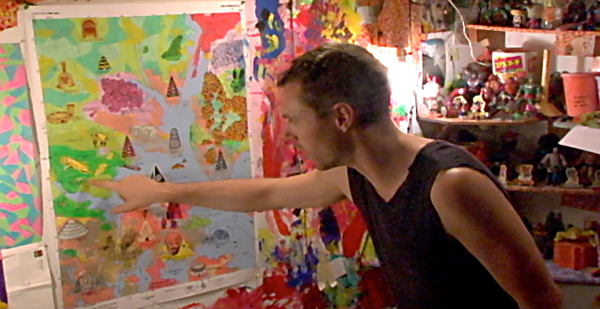|
Reviews of Recent Independent, Foreign, & Documentary Films in Theaters and DVD/Home Video

DIED YOUNG, STAYED PRETTY Early on in Died Young, Stayed Pretty, poster artist Art Chantry unintentionally sums up what is problematic about the documentary. As he is showing the audience a poster he made of famous people with zippers over their lips, he says, “What I decided to do was take pictures of all these celebrities I’m sick to death of and zipping their mouths shut.” As he details a number of figures in the poster—Courtney Love, Oprah, Celine Dion—he gets to a famous film director. “Oliver…this is that director, the guy who did JFK….” Off camera, director Eileen Yaghoobian prompts, “Oliver Stone.” Chantry continues with his screed, “He’s another guy that should shut the fuck up.” And thus the beginning presages the whole: an entire film of uninformed invective thrown casually at broad, meaningless targets. With the democratization of the means of filmmaking, there has been an explosion of films and new media covering any and all niches, nooks, cultural pockets, and sub-subgenres. This is, in principle, a good thing. Bringing these overlooked pockets of creativity to light helps to demythologize the standard narrative of mainstream media, and to reveal the contradictions that really create the writhing mass that is American culture. However, parts affect wholes just like wholes affect parts. If a large part of mainstream culture is oblivious and uninformed—yet wholly opinionated—then so are large contingents of those that make up these subcultures. Thus, bringing to light the craggy topography of the underground indie-rock-poster subculture doesn’t necessarily mean that the political debate is going to get any richer or that under appreciated art is actually aesthetically eye-opening. The strengths of Died Young then are the same reasons why ultimately it is not compelling as a film. Yaghoobian tries as little as possible to impose herself on the film. Obviously, the simple act of choosing a shot for the camera is already an act of creating narrative, but in the absence of stylistic tricks and overt narration, the poster artists are allowed to tell their own stories, and the film itself is created out of the pull between Yaghoobian and these various artists. The downside of that strategy is that if the other end doesn’t hold up, things start to fall apart. And from the artists’ end, there is a lot of broad, uninformed opinion, conjecture, and general misanthropic posturing.
In the rare moments when
they discuss the art of making posters and their aesthetic, there is a
spark of something worthwhile, but those moments are fleeting. Sure,
it’s of note that the practice of making arty posters for rock shows
happened in a disconnected fashion around the country until the Internet
brought everyone together, but by concentrating solely on the stories of
the people involved, we lose the bigger picture, the cultural
significance of this practice, and why it is noteworthy at all.
Considering the posters parallel other art movements (Polish
film
posters and the
Situationists),
it might have been beneficial to at least construct some kind of
narrative. This isn’t to second-guess Yaghoobian—she made the film she
wanted to make—but rather to offer why Died Young
feels lacking.
Andrew Beckerman
|

